Effects of Different Base Fertilizers on Water Use Efficiency and Growth of Maize During Growth Period
Abstract
1. Introduction
2. Materials and Methods
2.1. Experimental Site Description
2.2. Experimental Design
2.3. Soil and Maize Sample Treatment
2.4. Data Processing
3. Results
3.1. Effects of Different Base Fertilizers on Soil Volumetric Moisture Content
3.2. Effects of Different Base Fertilizer Combinations on Soil Water Consumption During Maize Growth Period
3.3. Effects of Different Base Fertilizers on the WUE of Maize
3.4. Effects of Different Base Fertilizers on Growth Traits of Maize
3.5. Effects of Different Base Fertilizers on Maize Yield and Its Constituent Factors
3.6. Relationship Between Maize Water Use Parameters and Maize Growth Traits Under Different Base Fertilizer Combinations
4. Discussion
4.1. Effects of Different Base Fertilizer Combinations on Soil Water Content and Soil Water Consumption During the Maize Growth Period
4.2. Effects of Different Base Fertilizers on WUE and Agronomic Traits of Maize
5. Conclusions
Author Contributions
Funding
Data Availability Statement
Acknowledgments
Conflicts of Interest
References
- Ding, L.; Huang, T.T.; Qin, W.; Zhou, J.X. Spatial variation of soil erosion in alpine and canyon areas of Southwest China. J. Sediment. Res. 2023, 48, 51–58+66. [Google Scholar]
- Wu, B.C.; Qi, S.; Guo, Z.X.; Liu, Z.; Chen, T. Effects of forest and spatial pattern and micro-topography on surface runoff in a mountainous area of southwestern China. Trans. Chin. Soc. Agric. Eng. 2021, 37, 108–116. [Google Scholar]
- Zhou, J.; Chen, X.Y.; Xie, D.T.; He, B.H.; Wei, S.Q. Effects of soil amendment polyacrylamide on physical properties and spatial variation of purple soil. J. Soil Water Conserv. 2009, 23, 171–177. [Google Scholar]
- Wu, Y.J.; Zhang, D.M.; Zeng, J.H.; Pan, X.Z.; Lei, F.; Xie, L.S. Effect of continuous application of soil amendments on rice-kidney bean rotation. Hubei Agric. Sci. 2017, 56, 2635–2638. [Google Scholar]
- Jiang, M.; Dong, C.; Bian, W.; Zhang, W.; Wang, Y. Effects of Different Fertilization Practices on Maize Yield, Soil Nutrients, Soil Moisture, and Water Use Efficiency in Northern China Based on a Meta-Analysis. Sci. Rep. 2024, 14, 6480. [Google Scholar] [CrossRef]
- Zhang, Y.; Ma, Q.; Liu, D.; Sun, L.; Ren, X.; Ali, S.; Zhang, P.; Jia, Z. Effects of Different Fertilizer Strategies on Soil Water Utilization and Maize Yield in the Ridge and Furrow Rainfall Harvesting System in Semiarid Regions of China. Agric. Water Manag. 2018, 208, 414–421. [Google Scholar] [CrossRef]
- Wang, X.; Jia, Z.; Liang, L.; Yang, B.; Ding, R.; Nie, J.; Wang, J. Impacts of Manure Application on Soil Environment, Rainfall Use Efficiency and Crop Biomass under Dryland Farming. Sci. Rep. 2016, 6, 20994. [Google Scholar] [CrossRef]
- Jia, R.; Zhou, J.; Chu, J.; Shahbaz, M.; Yang, Y.; Jones, D.L.; Zang, H.; Razavi, B.S.; Zeng, Z. Insights into the Associations between Soil Quality and Ecosystem Multifunctionality Driven by Fertilization Management: A Case Study from the North China Plain. J. Clean. Prod. 2022, 362, 132265. [Google Scholar] [CrossRef]
- Zhang, D.; Hao, X.; Fan, Z.; Hu, X.; Ma, J.; Guo, Y.; Wu, L. Optimizing Tillage and Fertilization Patterns to Improve Soil Physical Properties, NUE and Economic Benefits of Wheat-Maize Crop Rotation Systems. Agriculture 2022, 12, 1264. [Google Scholar] [CrossRef]
- Wu, S.; Wang, K.Q.; Song, Y.L.; Chen, B.S.; Wen, C.T.; Pei, Y.L.; Dai, L. Effects of straw compost retting on phosphorus balance of fluecured tobacco farmland ecosystem in red soil. J. South. Agric. 2022, 53, 1595–1603. [Google Scholar]
- Wu, Y.; Jia, Z.; Ren, X.; Zhang, Y.; Chen, X.; Bing, H.; Zhang, P. Effects of ridge and furrow rainwater harvesting system combined with irrigation on improving water use efficiency of maize (Zea mays L.) in semi-humid area of China. Agric. Water Manag. 2015, 158, 1–9. [Google Scholar] [CrossRef]
- Liu, Q.; Jia, Z.K.; Lian, Y.H.; Zhang, X.D.; Ren, X.L.; Wang, J.P.; Hang, Q.F. Effect of millet planting density on soil moisture and yield under ridge furrow rainfall harvesting mode. Agric. Res. Arid. Areas 2016, 34, 81–87. [Google Scholar]
- Xie, Z.; Wang, Y.; Li, F. Effect of plastic mulching on soil water use and spring wheat yield in arid region of northwest China. Agric. Water Manag. 2005, 75, 71–83. [Google Scholar] [CrossRef]
- Lian, Y.H.; Ali, S.; Zhang, X.D.; Wang, T.L.; Liu, Q.; Jia, Q.M.; Jia, Z.K.; Han, Q.F. Nutrient and tillage strategies to increase grain yield and water use efficiency in semi-arid areas. Agric. Water Manag. 2016, 178, 137–147. [Google Scholar] [CrossRef]
- Tang, C.; Yang, J.; Xie, W.; Yao, R.; Wang, X. Effect of Biochar Application on Soil Fertility, Nitrogen Use Efficiency and Balance in Coastal Salt-Affected Soil under Barley–Maize Rotation. Sustainability 2023, 15, 2893. [Google Scholar] [CrossRef]
- Wu, Y.; Huang, F.Y.; Jia, Z.K.; Ren, X.L.; Cai, T. Response of soil water, temperature, and maize (Zea may L.) production to different plastic film mulching patterns in semi-arid areas of northwest China. Soil Tillage Res. 2017, 166, 113–121. [Google Scholar] [CrossRef]
- Jensen, J.R.; Bernhard, R.; Hansen, S.; Mcdonagh, J.; Moberg, J.; Nielsen, N.E.; Nordbo, E. Productivity in maize based cropping systems under various soil-water-nutrient management strategies in a semiarid, alfisol environment in East Africa. Agric. Water Manag. 2003, 59, 217–237. [Google Scholar] [CrossRef]
- Yang, F.K.; He, B.L.; Zhang, G.P.; Zhang, L.G.; Gao, Y.P. Effects of soil fertilizing and mulched ridge tillage on soil nutrients, maize yield and water use efficiency. Chin. J. Appl. Ecol. 2019, 30, 893–905. [Google Scholar]
- Panjaitan, E. The Effect of Combination of Organic Fertilizer and Rice Husk Biochar on Growth, Production, Available N and N Absorption of Soybean (Glycine max L.) in Ultisol Soil. IJAEAM 2024, 2, 41–52. [Google Scholar] [CrossRef]
- Pahalvi, H.N.; Rafiya, L.; Rashid, S.; Nisar, B.; Kamili, A.N. Chemical Fertilizers and Their Impact on Soil Health. In Microbiota and Biofertilizers; Dar, G.H., Bhat, R.A., Mehmood, M.A., Hakeem, K.R., Eds.; Springer International Publishing: Cham, Switzerland, 2021; Volume 2, pp. 1–20. ISBN 978-3-030-61009-8. [Google Scholar]
- Zhong, Y.; Shangguan, Z.P. Water consumption characteristics and water use efficiency of winter wheat under long-term nitrogen fertilization regimes in Northwest China. PLoS ONE 2014, 9, e98850. [Google Scholar] [CrossRef]
- Gan, Y.T.; Siddique, K.H.M.; Turner, N.C.; Li, X.G.; Niu, J.Y.; Yang, C.; Liu, L.P.; Chai, Q. Chapter Seven-Ridge-Furrow Mulching Systems An innovative technique for boosting crop productivity in semiarid rain-fed environments. Adv. Agron. 2013, 118, 429–476. [Google Scholar]
- Bai, X.; Tang, J.; Wang, W.; Ma, J.; Shi, J.; Ren, W. Organic Amendment Effects on Cropland Soil Organic Carbon and Its Implications: A Global Synthesis. CATENA 2023, 231, 107343. [Google Scholar] [CrossRef]
- Guo, J.; Wang, Y.; Blaylock, A.D.; Chen, X. Mixture of Controlled Release and Normal Urea to Optimize Nitrogen Management for High-Yielding (>15 Mg Ha−1) Maize. Field Crops Res. 2017, 204, 23–30. [Google Scholar] [CrossRef]
- Xie, J.H.; Li, L.L.; Zhang, R.Z.; Chai, Q. Additive effects of mulching and furrow tillage on maize yield and water use in dry farmland. Acta Agron. Sin. 2018, 44, 268–277. [Google Scholar] [CrossRef]
- Fang, Y.; Van Zwieten, L.; Rose, M.T.; Vasileiadis, S.; Donner, E.; Vancov, T.; Rigg, J.L.; Weng, Z.; Lombi, E.; Drigo, B.; et al. Unraveling Microbiomes and Functions Associated with Strategic Tillage, Stubble, and Fertilizer Management. Agric. Ecosyst. Environ. 2022, 323, 107686. [Google Scholar] [CrossRef]
- Saidia, P.S.; Asch, F.; Kimaro, A.A.; Germer, J.; Kahimba, F.C.; Graef, F.; Semoka, J.M.R.; Rweyemamu, C.L. Soil Moisture Management and Fertilizer Micro-Dosing on Yield and Land Utilization Efficiency of Inter-Cropping Maize-Pigeon-Pea in Sub Humid Tanzania. Agric. Water Manag. 2019, 223, 105712. [Google Scholar] [CrossRef]
- Geng, Y.; Cao, G.; Wang, L.; Wang, S. Effects of Equal Chemical Fertilizer Substitutions with Organic Manure on Yield, Dry Matter, and Nitrogen Uptake of Spring Maize and Soil Nitrogen Distribution. PLoS ONE 2019, 14, e0219512. [Google Scholar] [CrossRef]
- Nadeem Shah, M.; Wright, D.L.; Hussain, S.; Koutroubas, S.D.; Seepaul, R.; George, S.; Ali, S.; Naveed, M.; Khan, M.; Tanveer Altaf, M.; et al. Organic Fertilizer Sources Improve the Yield and Quality Attributes of Maize (Zea mays L.) Hybrids by Improving Soil Properties and Nutrient Uptake under Drought Stress. J. King Saud Univ.—Sci. 2023, 35, 102570. [Google Scholar] [CrossRef]
- Wang, T.; Li, N.; Li, Y.; Lin, H.; Yao, N.; Chen, X.; Li Liu, D.; Yu, Q.; Feng, H. Impact of Climate Variability on Grain Yields of Spring and Summer Maize. Comput. Electron. Agric. 2022, 199, 107101. [Google Scholar] [CrossRef]
- Xu, Y.; Liu, X.; Yan, L.; Huang, X.; Wang, J. The Addition of Organic Fertilizer Can Reduce the Dependence of Dryland Yield on Rainfall-Based on a 32-Year Long-Term Study. Sci. Total Environ. 2024, 915, 170152. [Google Scholar] [CrossRef]
- Mushore, T.; Manatsa, D.; Pedzisai, E.; Muzenda-Mudavanhu, C.; Mushore, W.; Kudzotsa, I. Investigating the implications of meteorological indicators of seasonal rainfall performance on maize yield in a rain-fed agricultural system: Case study of Mt. Darwin District in Zimbabwe. Theor. Appl. Climatol. 2017, 129, 1167–1173. [Google Scholar] [CrossRef]
- Kiboi, M.N.; Ngetich, K.F.; Fliessbach, A.; Muriuki, A.; Mugendi, D.N. Soil Fertility Inputs and Tillage Influence on Maize Crop Performance and Soil Water Content in the Central Highlands of Kenya. Agric. Water Manag. 2019, 217, 316–331. [Google Scholar] [CrossRef]
- Martineau, E.; Domec, J.-C.; Bosc, A.; Denoroy, P.; Fandino, V.A.; Lavres, J.; Jordan-Meille, L. The Effects of Potassium Nutrition on Water Use in Field-Grown Maize (Zea mays L.). Environ. Exp. Bot. 2017, 134, 62–71. [Google Scholar] [CrossRef]
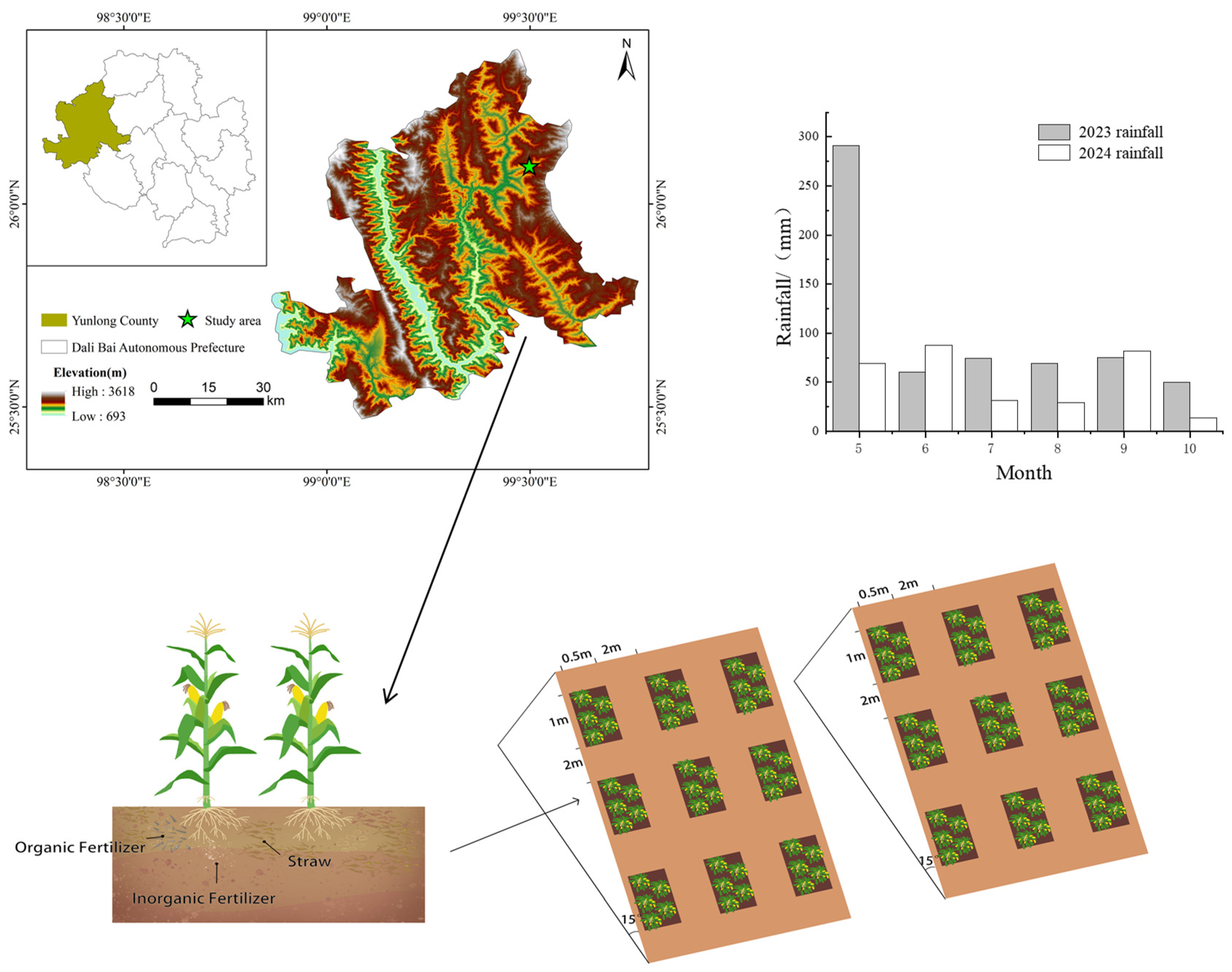

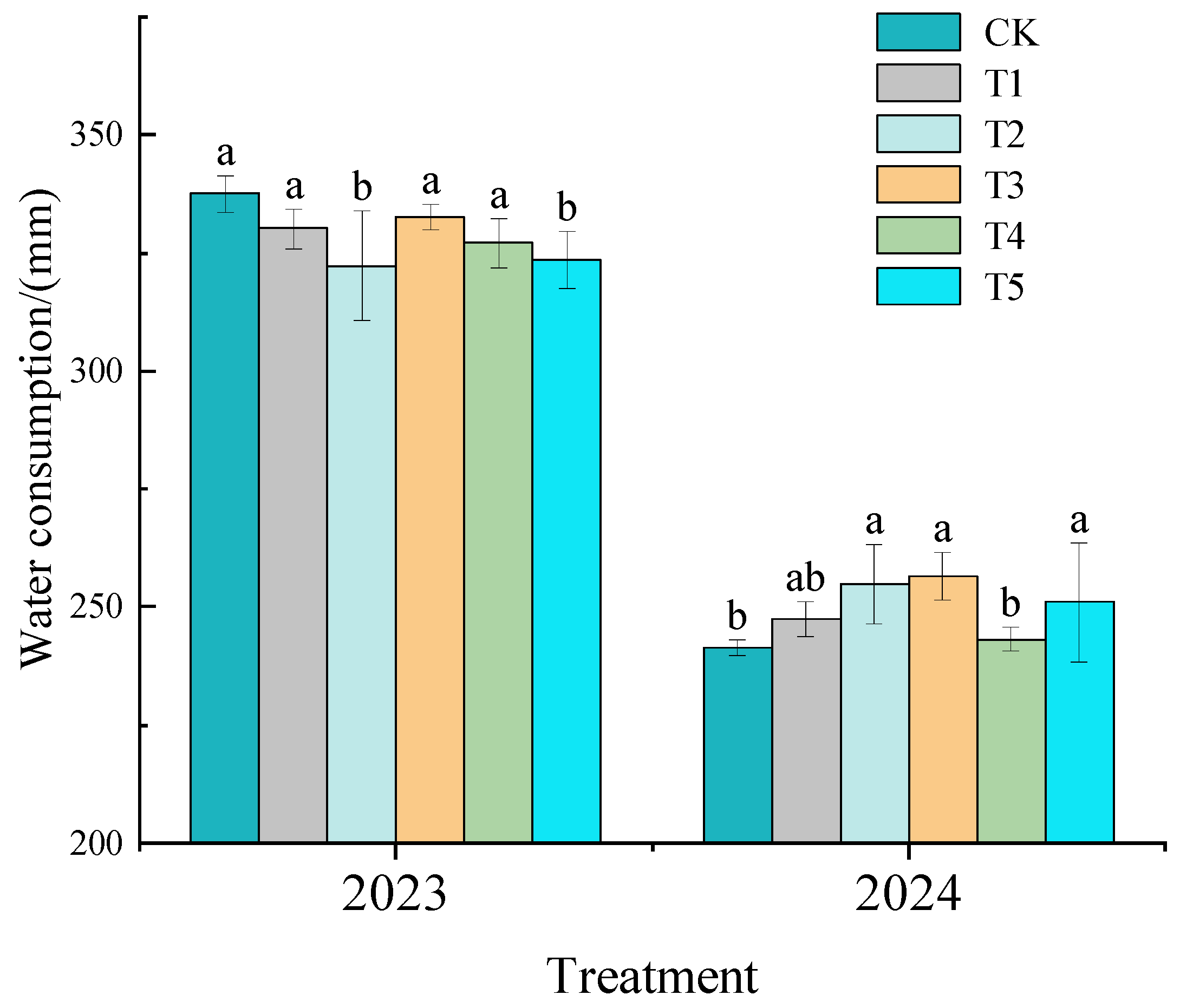
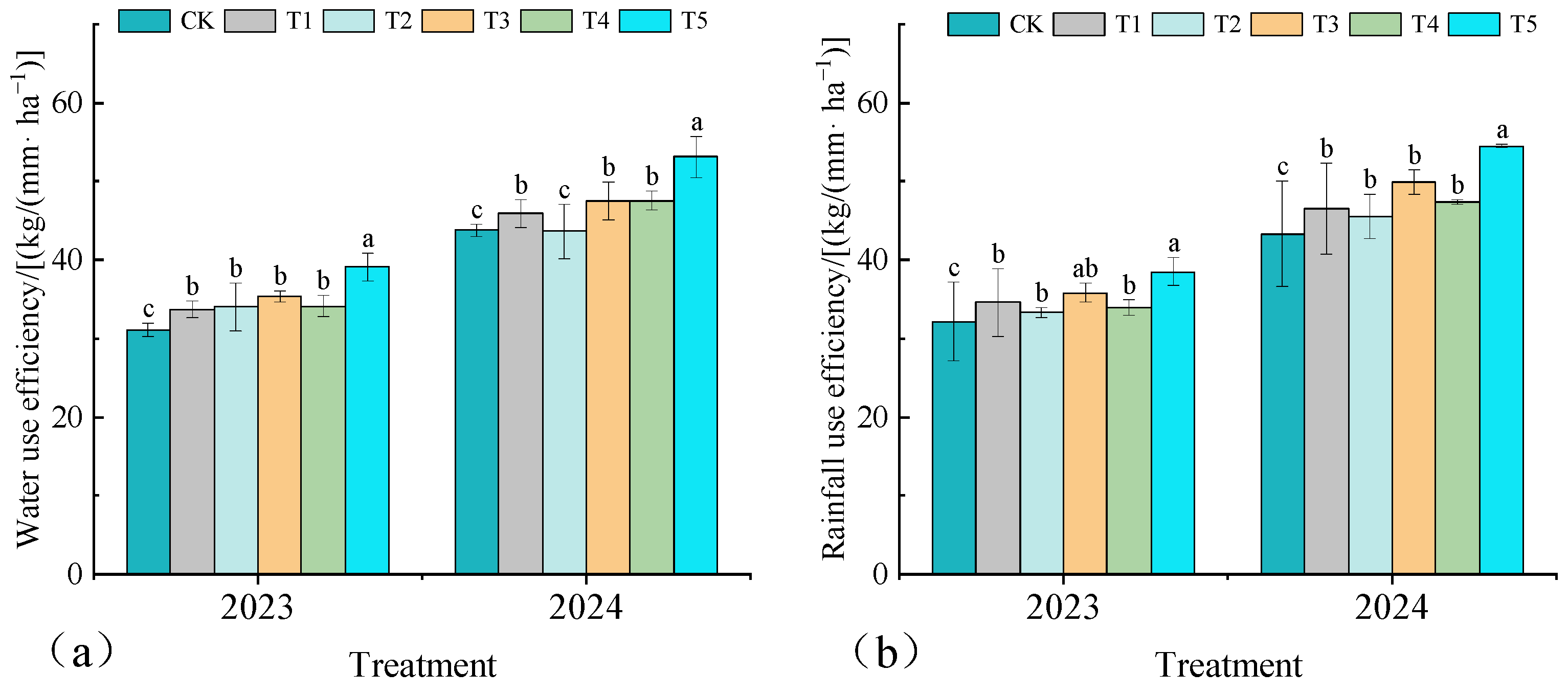
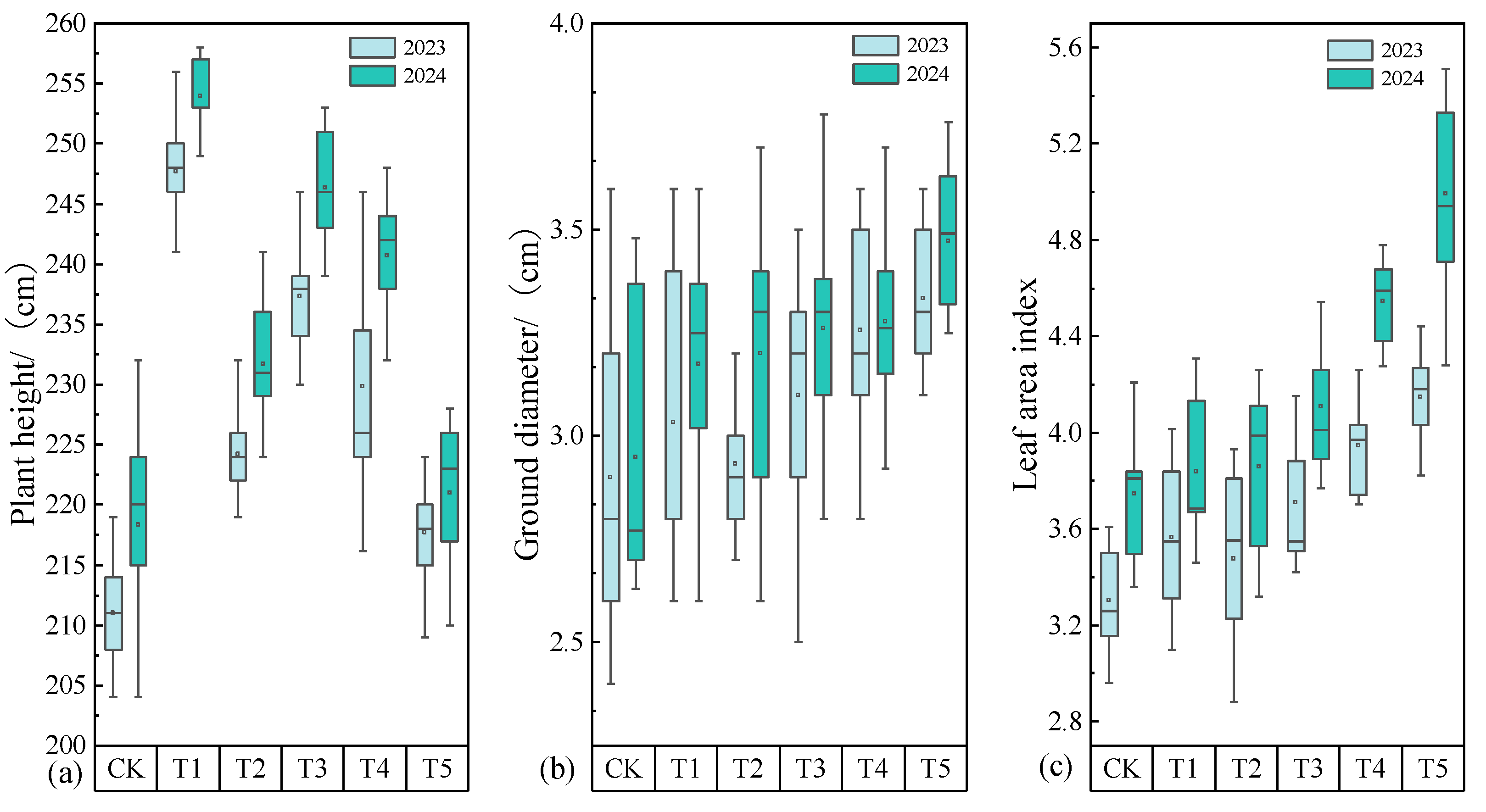
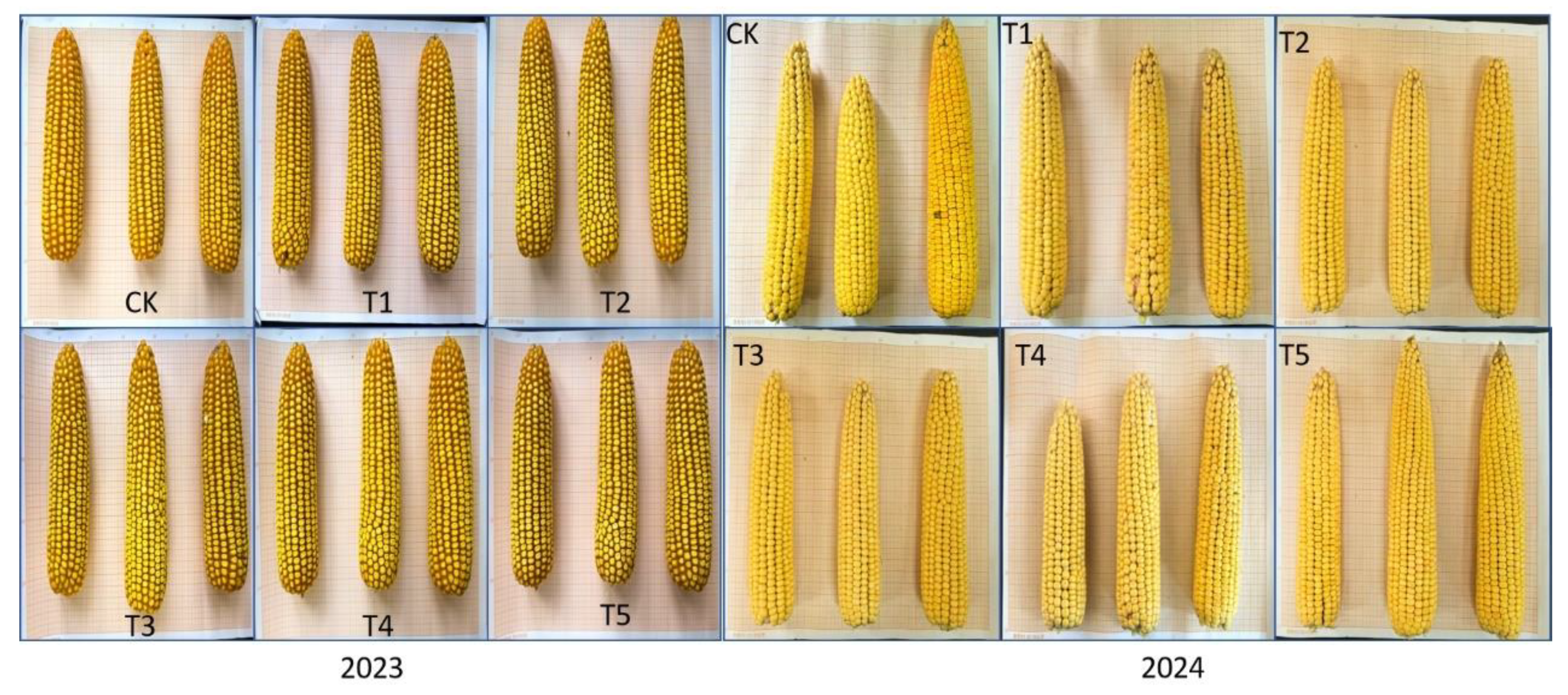
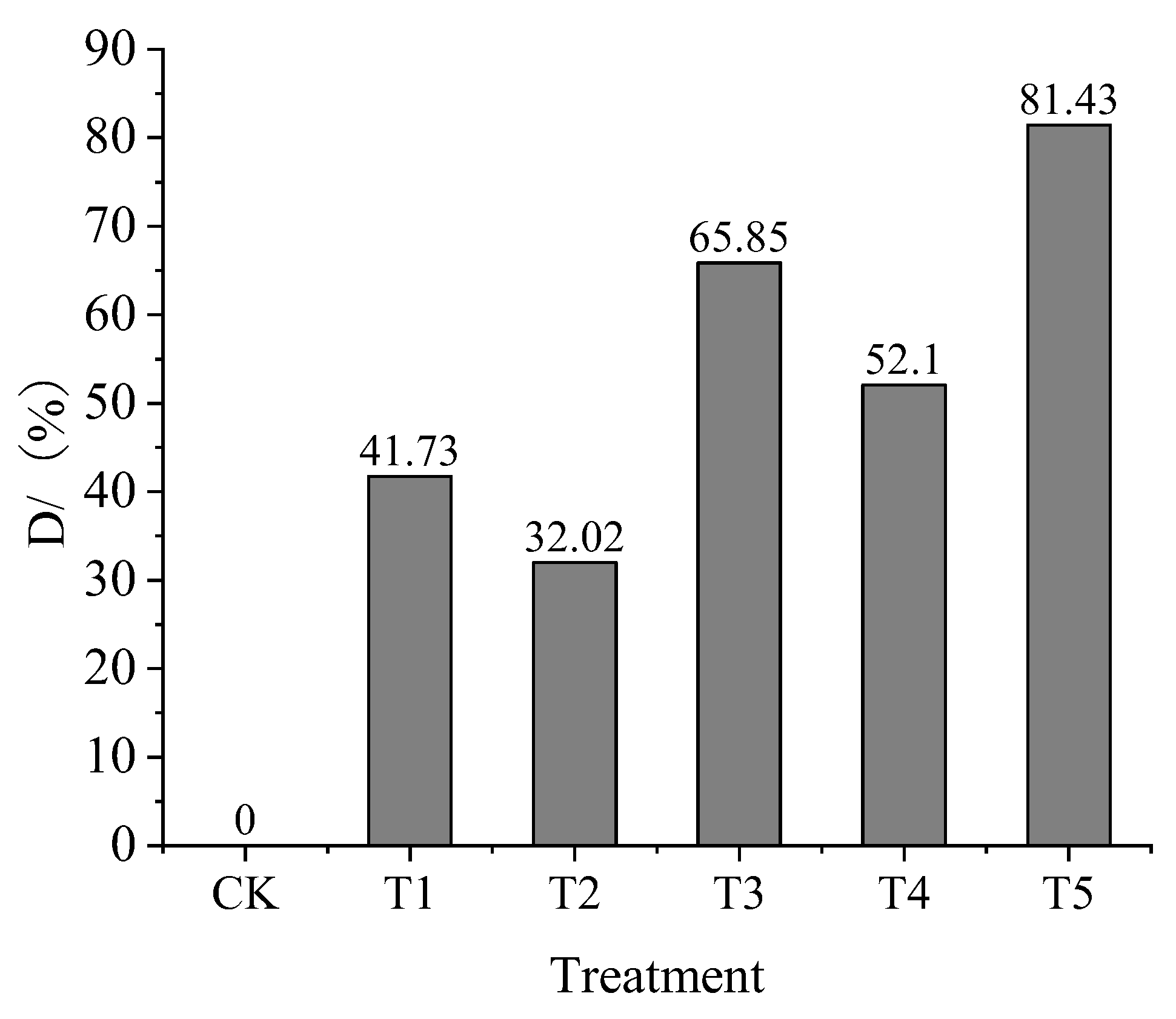
| Index | Unit | Soil Depth/cm | ||
|---|---|---|---|---|
| 0–10 cm | 10–20 cm | 20–40 cm | ||
| Organic Matter | g kg−1 | 47.50 | 23.16 | 19.48 |
| Total Nitrogen | g kg−1 | 0.34 | 0.23 | 0.16 |
| Total Phosphorus | g kg−1 | 0.83 | 0.78 | 0.75 |
| Total Potassium | g kg−1 | 3.78 | 3.48 | 2.38 |
| Available Nitrogen | mg kg−1 | 38.26 | 27.53 | 18.73 |
| Available Phosphorus | mg kg−1 | 36.47 | 15.50 | 6.69 |
| Available Potassium | mg kg−1 | 10.98 | 10.30 | 9.32 |
| Bulk Density | g cm−3 | 1.46 | 1.52 | 1.58 |
| Volume Moisture Content | % | 17.14 | 20.55 | 24.36 |
| Texture (Sand/soil/clay) | % | 14.30, 31.41, 54.10 | 12.37, 35.45, 52.77 | 13.12, 35.55, 49.25 |
| pH | 5.15 | 4.92 | 4.81 | |
| Group | Fertilizer Type | Base Fertilizer | Jointing Fertilizer | Trumpet Fertilizer |
|---|---|---|---|---|
| CK | 0 | 0 | 21.5 | 43 |
| T1 | Organic | 1000 | 21.5 | 43 |
| T2 | Inorganic | 80 | 21.5 | 43 |
| T3 | Organic, Inorganic | 500, 40 | 21.5 | 43 |
| T4 | Straw | 1500 | 21.5 | 43 |
| T5 | Straw, urea | 1500, 37.5 | 21.5 | 43 |
| Year | Treatment | Panicle Weight (g) | Panicle Length (cm) | Grain Number (No/Ear) | 100-Grain Weight (g) | Yield (t/ha) |
|---|---|---|---|---|---|---|
| 2023 | CK | 327.90 d | 20.13 b | 521.67 c | 29.85 d | 10.49 c |
| T1 | 347.62 c | 20.60 b | 557.00 c | 34.87 c | 11.12 b | |
| T2 | 342.34 c | 20.28 b | 582.00 b | 34.13 c | 10.96 b | |
| T3 | 367.96 b | 20.87 b | 577.33 b | 35.73 b | 11.78 a | |
| T4 | 349.00 c | 21.73 ab | 600.33 b | 35.31 b | 11.17 b | |
| T5 | 395.43 a | 23.79 a | 734.33 a | 36.64 a | 12.65 a | |
| 2024 | CK | 330.41 c | 15.60 c | 560.67 c | 29.70 b | 10.57 d |
| T1 | 355.19 c | 20.00 ab | 595.33 b | 35.21 a | 11.37 c | |
| T2 | 347.41 c | 19.53 ab | 600.00 c | 36.16 a | 11.12 c | |
| T3 | 380.83 ab | 19.80 ab | 607.33 b | 38.47 a | 12.19 b | |
| T4 | 361.53 b | 20.13 ab | 605.33 b | 37.24 a | 11.57 c | |
| T5 | 415.95 a | 21.87 a | 677.33 a | 38.44 a | 13.31 a |
| Indicators | Explains/% | Contribution/% | Pseudo-F | p |
|---|---|---|---|---|
| GY | 54.3 | 82.8 | 19 | 0.002 * |
| LAI | 3.8 | 5.7 | 1.3 | 0.024 * |
| HW | 3.3 | 5.1 | 1.2 | 0.034 * |
| H | 3.5 | 5.3 | 1.3 | 0.320 |
| D | 0.7 | 1.1 | 0.2 | 0.864 |
| Index | PCA 1 | PCA 2 |
|---|---|---|
| Soil volumetric moisture content | 0.149 | 0.029 |
| Soil water consumption | −0.037 | 0.494 |
| Water use efficiency | 0.153 | −0.049 |
| Rainfall use efficiency | 0.15 | 0.044 |
| Maize plant height | 0.007 | 0.538 |
| Maize stem diameter | 0.155 | −0.032 |
| Maize leaf area index. | 0.149 | −0.169 |
| 100-grain Weight | 0.136 | 0.26 |
| Yield | 0.15 | 0.038 |
| Eigenvalue | 6.362 | 1.569 |
| Variance contribution rate | 70.685 | 17.438 |
| Cumulative variance contribution rate | 70.685 | 88.123 |
Disclaimer/Publisher’s Note: The statements, opinions and data contained in all publications are solely those of the individual author(s) and contributor(s) and not of MDPI and/or the editor(s). MDPI and/or the editor(s) disclaim responsibility for any injury to people or property resulting from any ideas, methods, instructions or products referred to in the content. |
© 2025 by the authors. Licensee MDPI, Basel, Switzerland. This article is an open access article distributed under the terms and conditions of the Creative Commons Attribution (CC BY) license (https://creativecommons.org/licenses/by/4.0/).
Share and Cite
Wang, Z.; Wang, K.; Liu, X.; Zhu, W.; Deng, X.; Zhao, Y. Effects of Different Base Fertilizers on Water Use Efficiency and Growth of Maize During Growth Period. Agronomy 2025, 15, 491. https://doi.org/10.3390/agronomy15020491
Wang Z, Wang K, Liu X, Zhu W, Deng X, Zhao Y. Effects of Different Base Fertilizers on Water Use Efficiency and Growth of Maize During Growth Period. Agronomy. 2025; 15(2):491. https://doi.org/10.3390/agronomy15020491
Chicago/Turabian StyleWang, Zhenchao, Keqin Wang, Xinyi Liu, Wanjing Zhu, Xiangyin Deng, and Yangyi Zhao. 2025. "Effects of Different Base Fertilizers on Water Use Efficiency and Growth of Maize During Growth Period" Agronomy 15, no. 2: 491. https://doi.org/10.3390/agronomy15020491
APA StyleWang, Z., Wang, K., Liu, X., Zhu, W., Deng, X., & Zhao, Y. (2025). Effects of Different Base Fertilizers on Water Use Efficiency and Growth of Maize During Growth Period. Agronomy, 15(2), 491. https://doi.org/10.3390/agronomy15020491






